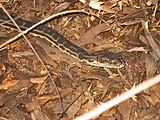Superregnum: Eukaryota
Regnum: Animalia
Subregnum: Eumetazoa
Cladus: Bilateria
Cladus: Nephrozoa
Superphylum: Deuterostomia
Phylum: Chordata
Cladus: Craniata
Subphylum: Vertebrata
Infraphylum: Gnathostomata
Superclassis: Tetrapoda
Cladus: Reptiliomorpha
Cladus: Amniota
Classis: Reptilia
Cladus: Eureptilia
Cladus: Romeriida
Subclassis: Diapsida
Cladus: Sauria
Infraclassis: Lepidosauromorpha
Superordo: Lepidosauria
Ordo: Squamata
Subordo: Serpentes
Infraordo: Henophidia
Familia: Pythonidae
Genus: Morelia
Species (6): M. azurea – M. bredli – M. carinata – M. imbricata – M. spilota – M. viridis
Name
Morelia Gray, 1842
Synonyms
Morelia Gray, 1842
Chondropython Meyer, 1874
Australiasis]] Wells & Wellington, 1984
Nyctophilopython]] Wells & Wellington, 1985
Montypythonoides]] Smith & Plane, 1985
Lenhoserus]] Hoser, 2000
Jackypython]] Hoser, 2009 (unavailable name)
Original status: valid subgenus of Morelia
Gender: masculine
Type species: Python carinatus Smith, 1980
Fixation: original designation [p. 23] [and monotypy]
References
Schleip, W.D.; O'Shea, M. 2010: Annotated checklist of the recent and extinct pythons (Serpentes, Pythonidae), with notes on nomenclature, taxonomy, and distribution. ZooKeys, 66: 29–79. ISSN: 1313-2970 (online) ISSN: 1313-2989 (print) DOI: 10.3897/zookeys.66.683
Kaiser, H., Crother, B.I., Kelly, C.M.R., Luiselli, L., O'Shea, M., Ota, H., Passos, P., Schleip, W. & Wüster, W. 2013: Best practices: in the 21st century, taxonomic decisions in herpetology are acceptable only when supported by a body of evidence and published via peer-review. Herpetological Review, 44: 8–23. [1]
Vernacular names
Deutsch: Rautenpythons
日本語: オマキニシキヘビ属
Morelia is a genus of large snakes in the family Pythonidae found in Indonesia, New Guinea, and throughout Australia. Currently, up to eight species are recognized.[3]
In general, these snakes are arboreal to semiarboreal, spending much of their lives in the forest canopy. Although exceptions occur, most attain adult lengths of 2–3 m (6.6–9.8 ft).
Geographic range
Species are found from Indonesia in the Maluku Islands, east through New Guinea, including the Bismarck Archipelago and in Australia.[1]
Species
Seven species are recognized:[4]
| Species[3] | IUCN Status[5] | Taxon author[3] | Subsp.*[3] | Common name | Geographic range[1] |
|---|---|---|---|---|---|
| M. azurea | (Meyer, 1874) | 2 | Green tree python, southern green python | Papua New Guinea (Biak, Numfor and Supiori in the Schouten Islands group of Cenderawasih Bay) | |
| M. bredli
|
(Gow, 1981) | 0 | Bredl's python; Centralian python | Australia, in the mountains of southern Northern Territory | |
| M. carinata
|
(L.A. Smith, 1981) | 0 | Rough-scaled python | Australia, northwestern Western Australia in the lower sections of the Mitchell and Hunter rivers, just inland from the coast | |
| M. imbricata
|
(L.A. Smith, 1981) | 0 | Southern carpet python | New Guinea, Australia (New South Wales, Northern Territory, Queensland, South Australia, Victoria, Western Australia) | |
| M. spilotaT
|
LC[6] LR/nt[7] |
(Lacépède, 1804) | 5 | Carpet python; diamond python | Indonesia (southern Western New Guinea in Merauke Regency), Papua New Guinea (southern Western Province, the Port Moresby area of Central Province and on Yule Island) and Australia (excluding much of the center and north west of the country) |
M. viridis  |
LC[8] | (Schlegel, 1872) | 0 | Green tree python | Indo/Papuan: Indonesia (Misool, Salawati, Aru Islands, Schouten Islands, most of Western New Guinea), Papua New Guinea (including nearby islands from sea level to 1,800 m elevation, Normanby Island and the d'Entrecasteaux Islands)
Australian: Queensland along the east coast of the Cape York Peninsula |
| M. riversleighensis† | (Smith and Plane, 1985) | 0 | n/a | Extinct, remains found in Queensland, Australia |
*) Not including the nominate subspecies
T) Type species.[1]
Hybrids
Morelia spilota X viridis[citation needed]
References
McDiarmid RW, Campbell JA, Touré T. (1999). Snake Species of the World: A Taxonomic and Geographic Reference, vol. 1. Herpetologists' League. 511 pp. ISBN 1-893777-00-6 (series). ISBN 1-893777-01-4 (volume).
Scanlon, J.D. (2001). "Montypythonoides revisited: the Miocene snake Morelia riversleighensis (Smith and Plane, 1985) and the question of pythonine origins". In Hand, S.J.; Laurie, J.R. (eds.). Riversleigh Symposium 1998: Proceedings of a Research Symposium on Fossils from Riversleigh and Murgon, Queensland, held at the University of New South Wales, December, 1998. Memoirs of the Association of Australasian Palaeontologists 25. pp. 1–35.
"Morelia". Integrated Taxonomic Information System. Retrieved 10 September 2007.
Morelia at the Reptarium.cz Reptile Database. Accessed 1 January 2020.
International Union for Conservation of Nature and Natural Resources. "IUCN Red List of Threatened Species".
Shine R.A. & Allison, A. (2010). "Morelia spilota". IUCN Red List of Threatened Species. 2010. Retrieved 28 March 2014.
Australasian Reptile & Amphibian Specialist Group (1996). "Morelia spilota ssp. imbricata". IUCN Red List of Threatened Species. 1996. Retrieved 28 March 2014.
Auliya, M.; Shine R.A. & Allison, A. (2010). "Morelia viridis". IUCN Red List of Threatened Species. 2010: e.T177524A7449431. doi:10.2305/IUCN.UK.2010-4.RLTS.T177524A7449431.en. Retrieved 15 January 2018.
Retrieved from "http://en.wikipedia.org/"
All text is available under the terms of the GNU Free Documentation License





